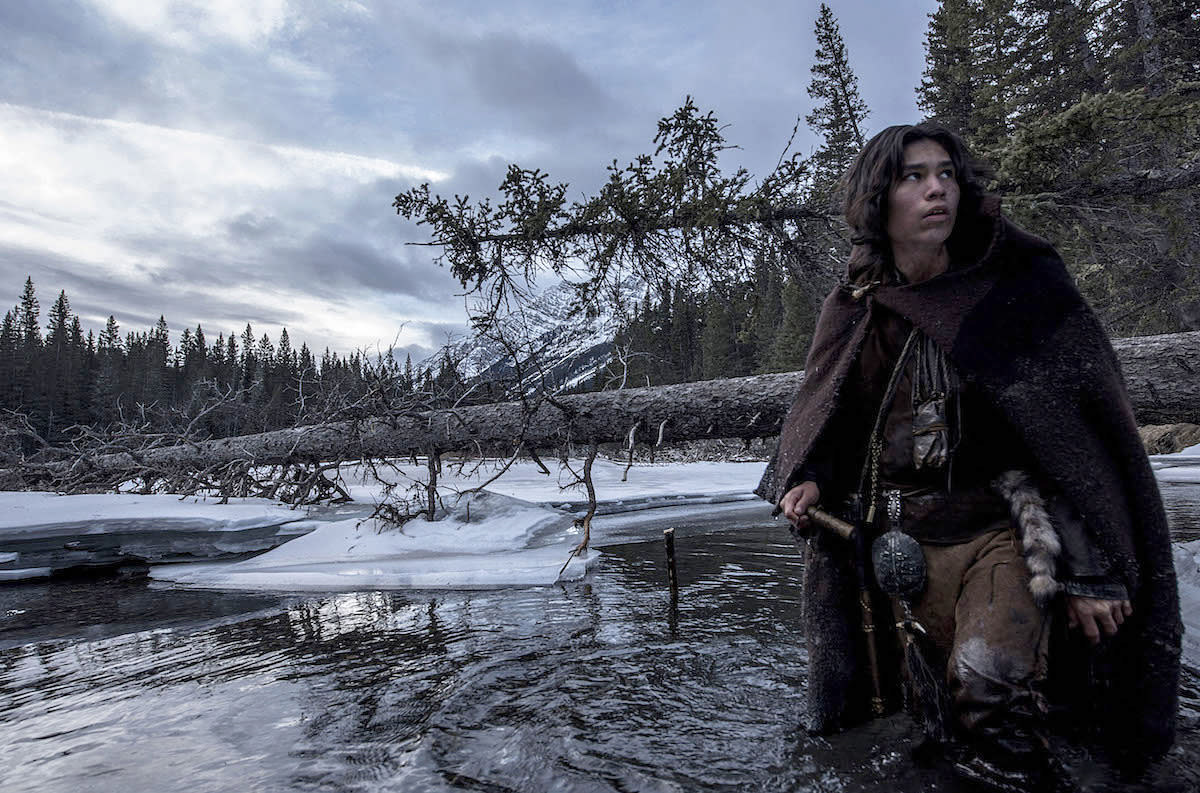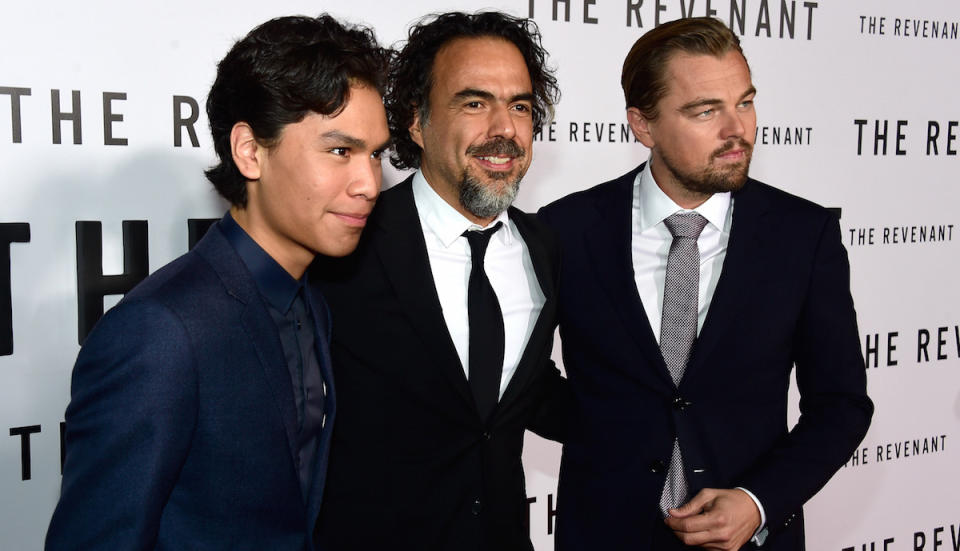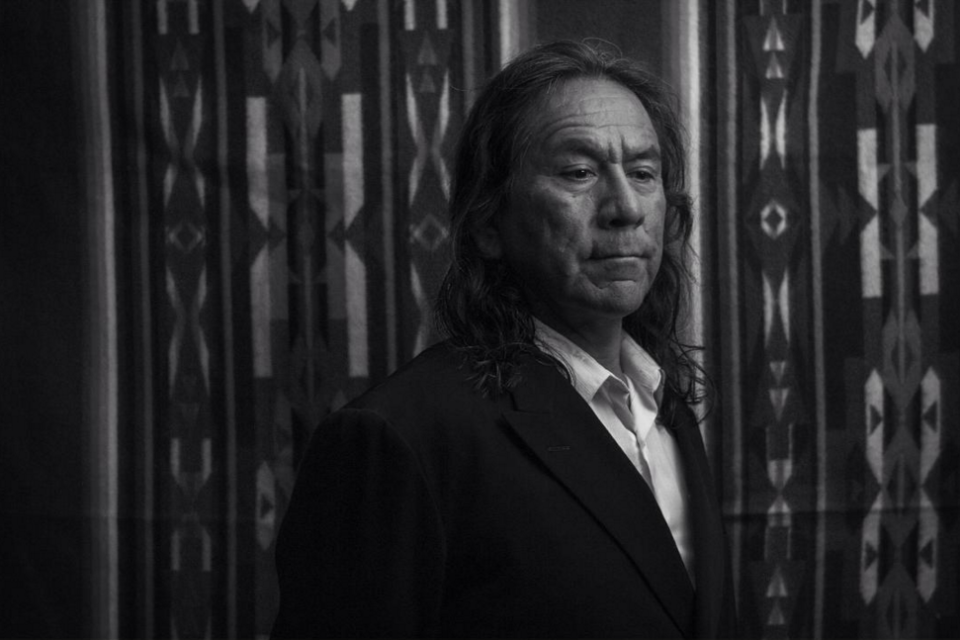20 Questions With ‘The Revenant’ Breakout Star Forrest Goodluck

Forrest Goodluck in ‘The Revenant.’
Alejandro González Iñárritu’s The Revenant has earned high marks — and three Golden Globe awards — for its scenic beauty and rugged brutality. A harrowing survival tale based on early 1800s frontiersman Hugh Glass (Leonardo DiCaprio), the film is also winning praise for its powerful performances — one of which comes from Forrest Goodluck in his first major film role. Goodluck, still in high school, plays Glass’s half-Pawnee son, Hawk. Without spoiling the film, Goodluck holds his own among his more seasoned costars Tom Hardy, Will Poulter, Domhnall Gleeson, and DiCaprio, in some very intense scenes shot in wintry landscapes. Get to know Goodluck and see how he handled himself in the film’s frigid, outdoor locations:
1. How old are you?
I’m 17.
2. Where are you from?
Albuquerque, New Mexico.
3. Are you applying to colleges?
Yeah. I’m looking at schools now and finishing up the college process. I’m definitely looking at Los Angeles. I’ve applied to USC, UCLA, and open to New York — places where great minds gather.
4. I’ve read you belong to several tribes. Can you describe them?
The Dine is the Navajo nation. Mandan and Hidatsa are people up in North Dakota. And the Tsimshian are in Alaska. My father comes from the Navajo people in Shiprock, New Mexico, in the Four Corners area. That is the Dine, which means “the people” in Navajo. If you ever hear the name of a native tribe it usually translates to “the people” or “human beings.” My grandmother on my mother’s side is from the Fort Berthold reservation in North Dakota — which is the reservation where the Arikara are from. The Arikara, of course, are in The Revenant.
5. How did you get cast in The Revenant?
[Laughs] A lot of auditioning. It’s been a crazy experience. One minute I’m in a plane in New Mexico flying over to L.A. and Calgary [Canada] for these weeklong trips to perfect this character. They really took faith in me. I’m really glad Alejandro saw something in me.
6. How did you get into character?
I was working with an acting coach named Angela Gibbs, who has a history with Alejandro and even helped Michael Keaton in Birdman. She transformed me into an actor. I couldn’t have done that without her. She taught me to layer. Every day it would be deepening the character more and more. … We would do this thing they call projecting where I’d take a character, Leonardo DiCaprio who plays my father Hugh Glass, and I’d imagine him as my actual father. I was seeing it from all these different angles and adding it up to what you see on screen.

From left: Goodluck, Iñárritu, and DiCaprio at the film’s Hollywood premiere Dec. 16.
7. What were your working days like with Leonardo DiCaprio?
There was a bunch of rehearsal before we even picked up the camera. He is so smart. He was never judgmental with me. People [in the film], like Leonardo DiCaprio, Tom Hardy, Will Poulter, or Domhnall Gleeson, were never judgmental with me at all. They always helped me out through each scene. Of course, this is my first film, having that certain level of intimidation and seeing them as very human, normal people, helped me every day.
8. Was there a moment with DiCaprio when you two felt you’d achieved the right dynamic together as actors?
We’re both in a boat together waiting for a scene to happen. It’s downtime and we’re both waiting for the cameras to start. We get to talking and he looks at me and he pulls me close and says [paraphrasing], “Look, you don’t have to worry too much about what we’re doing because, yes, this film is going to be tough, but I’ve never done a film like this either.” What he said to me was so humbling — that we’re both, literally, in the same boat together. It was a moment where I was just like, finally [exhales], just let go. I realized it was a new experience for everybody, including the director, the cinematographer, all of the cast, all of the crew. It captured such a harsh reality and such beauty that had never been captured on film before. We were experimenting to create something great.
9. What sort of direction did Alejandro González Iñárritu give you?
He’s a man of truth. Everything has to make sense in his head before he even picks up the camera, so he’ll often close his eyes and think really deeply about what he wants the scene to be. He can tell in an instant if you’re not being truthful. The eyes are wavering or there’s one beat or moment when you can lose it. He’ll know in an instant and start that scene over. He would never ask me to do something that he didn’t think I could do. It’s that faith and belief in all the actors he had, including me, that made this movie so realistic, truthful, and beautiful. It added confidence to what I did in the film.
10. You were braving the cold just like everyone else. Do you have a memory about the experience that stands out?
They say if you can’t change it embrace it. That’s what I went through. I just loved every day when I couldn’t feel feet or my hands. I’d say to myself, “This is great. This is awesome.” That deep cold in your bones — it’s an exhilarating feeling. It’s almost like a drug: You feel really cold, your blood is rushing, you’re yelling and screaming, doing all these interesting things you’ve never have the chance to do before. For me it was taking every day in stride, being grateful, and loving being out in the elements because where else would I be? Would I rather be at home doing school work or would I rather be in a scene with all these great minds?
11. What kind of acting training have you received?
The Bosque School is the school I’ve gone to since middle school. I did the drama class there. I also learned at an auditioning class and an improv class at the Sol Acting Academy, which is run by [actress] Vivian Nesbitt. She saw me and told my mother, “Hey, your son is very present and very good at film acting. You should try it out.” That’s when we first started auditioning for films. I had gotten roles before, but all of them actually fell through until this one. When I was 13 or 14 I was cast in a film called Man Called Buffalo, directed by the native film director Chris Eyre, who had done Smoke Signals. The casting director, Rene Haynes, had taken liking to me as an actor. Even though the film didn’t ultimately get made, she kept me on her radar. She is a very prevalent native casting director who also cast the [Uley] wolf pack for the Twilight series. She sent me roles before and a lot of them I had gotten but the films ultimately didn’t get made. The Revenant is the first one that stuck.
12. Can you list any other film roles that fell through?
I had been cast in Jane Got a Gun. Of course, that film took a while to get off the ground. There’s the idea that it’s cursed. I had gotten on set and they did test shots of me and I met [then] director Lynne Ramsay, who is an amazing woman. But there was a falling out [among the filmmakers]. I still got paid for that day on set. So I took that money bought a little DSLR camera and started making my own films.
13. I saw your Instagram page. Clearly, you’re also into photography.
I’ve always loved the camera. I often times like to be behind the camera photographing other people.
14. You’re also getting your photo taken on this press tour.
Oh yes. It’s crazy seeing all these photographers yelling “Forrest! Forrest! Look over here! Look to the left!”

15. You shared a really cool black-and-white photo of your dad on Instagram (above). Can you tell me about him?
That was a huge homage to my father. He’s a quieter man. He’s a physician. He’s very smart. He loves his work and loves to help people. That’s where I’m coming from. I’m trying to be grounded in what I do.
16. Who else influences you?
The main advice that I’ve gotten from my elders, my tribes, my people is that I need to better the world for the generation to come. Having a Native American background, everybody who has survived the genocide in this country has sacrificed so much. For me to acting in a film, I’m so grateful that that happened. I need to find that grounded-ness in the culture because everyone behind me survived in a country that didn’t necessarily accept them. My goal is definitely to pay homage to my ancestors for generations to come.
17. You have also won some film festival awards for your directing. Have you ever appeared in one of your own films?
I have. I’ve acted in front of the camera as well as directed a scene — which is a difficult thing to do. People like Ben Affleck have done that. It is an interesting thing to try to be on both sides. I like to experiment with a bunch of things. I definitely come from a Robert Rodriguez type of filmmaking, where you just have to go out and make the film. Whether it’s horrible or whether it’s great, you learn something from it.
18. How many times have you seen The Revenant so far?
I’ve seen the movie four times. Every time I notice something. Even if I wasn’t in the film I would still be studying it because it’s so deep and so meaningful. I take a lot from it, not coming from the point of view where I’m watching myself, but from the production — what the cast and crew conceived.
19. What’s been the most surreal thing that’s happened during your experience of making the movie?
The elements. Knowing that all these trees and mountains were there hundreds of years before I was born and are going to be there hundreds of years after I’m gone. Knowing that this film isn’t going to be the buzz that dies out in a couple months. This film really means something and is going to have some deep impact.
20. Now that you’ve been in The Revenant, are you planning to act more?
I have been reading for a few roles, auditioning, and doing that whole process. I’m definitely focusing on my acting career right now and taking that as far as it can go.
The Revenant is in theaters now.
Photos: 20th Century Fox, Forrest Goodluck, Frazer Harrison/Getty Images

